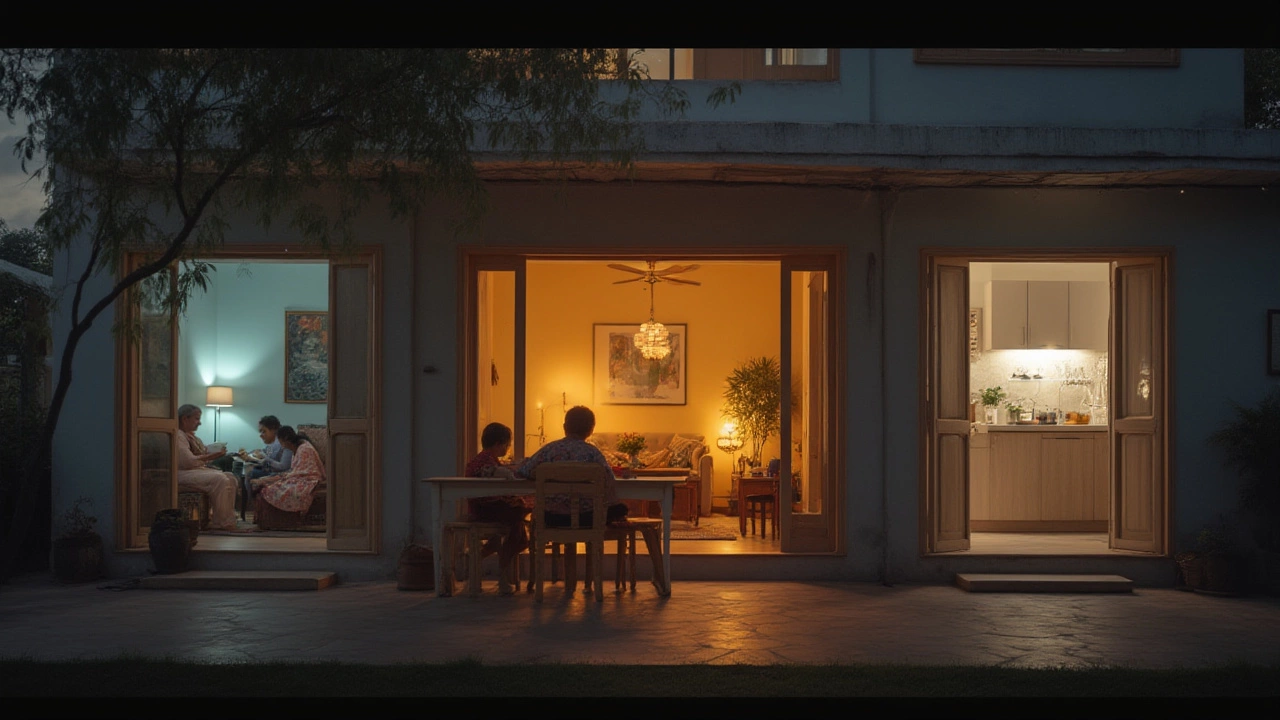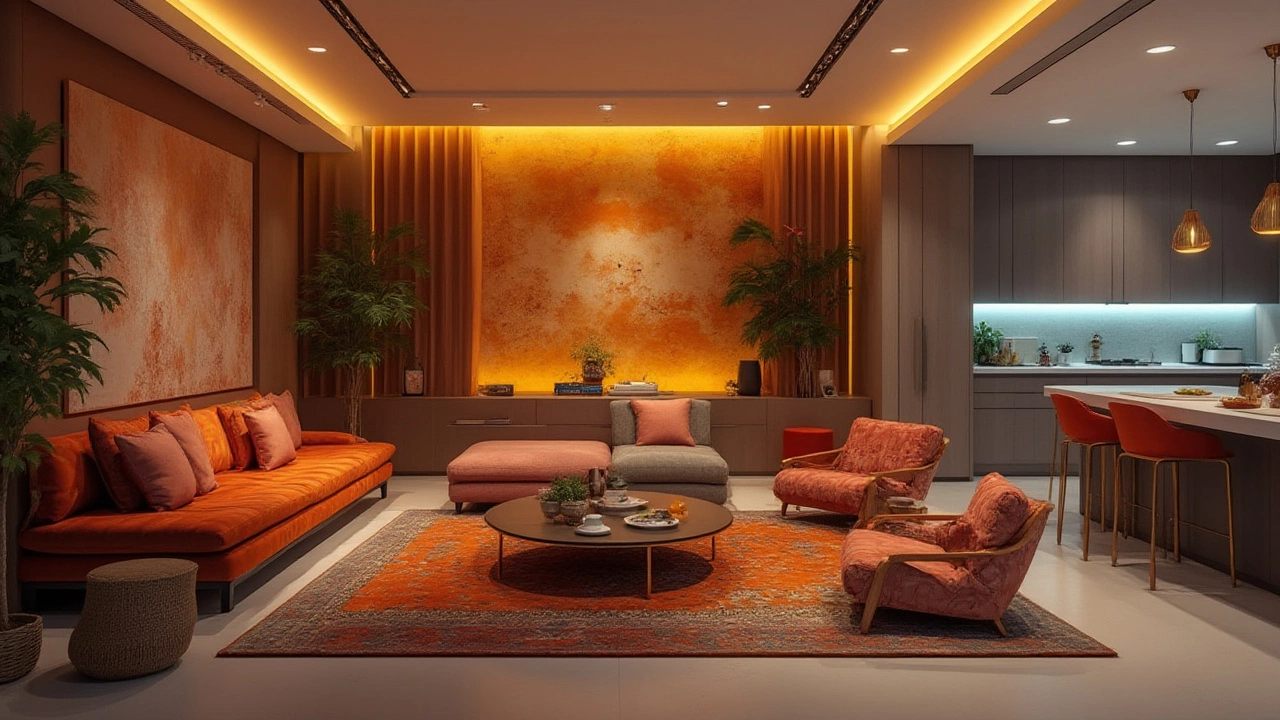Walk into a home where every room is bathed in the exact same brightness and color, and something feels a bit off, right? Imagine your kitchen starkly lit like a hospital, then wandering into a living room that's just as clinical. Yet, plenty of people stick to identical lighting across the whole house, either for simplicity or just because it seems like the easiest route. The question is: does that really make sense? Or is it holding your space back from reaching its true potential? Lighting can shape your mood, improve your focus, and even change the way you see your home.
Why Lighting Affects Every Room Differently
Take a moment and think about all the stuff that happens in different parts of your home. The kitchen isn’t just a spot for cooking—sometimes it’s your late-night snack station, homework zone, or the starting point for rushed mornings. Now, imagine that same kitchen blindingly lit 24/7, or worse, a dim yellow haze that makes it impossible to chop carrots without fearing for your fingertips. Rooms aren’t just walls and floors—they run on routines, vibes, and moods that shift all day long. Lighting plays into that more than most people realize.
Studies by the American Society of Interior Designers show that the right color temperature and brightness can boost productivity by up to 12% and even help with memory retention. Warmer lighting (think soft, yellow tones) actually tells your brain it’s time for winding down, often used in bedrooms and living spaces. Cooler, whiter light helps you stay alert, so it’s better for desks, bathrooms, and kitchens. Your dog Bailey might not care about warm ambiance, but your family, guests, and even your own energy levels will definitely notice when the lighting’s off.
Besides color temperature, there’s brightness (measured in lumens), direction (where the light hits), and layering. Hallways don’t need blazing light—just enough to keep things safe. Reading nooks need a happy medium that keeps pages crisp but won’t give you a headache. Bathroom mirrors? You want even, shadow-free lighting that actually lets you see what you’re doing. There’s no one-size-fits-all, even if a single bulb would be easier to shop for.
If you look around pro-designed homes, you’ll see the pros never treat every room the same. They mix recessed lighting, pendants, wall sconces, and clever LED accents so that every zone tells its own story. If you stick to cookie-cutter lighting everywhere, even that trendy new sofa or that quirky art you found will lose its magic. Think about how a muted spotlight can make a sculpture pop, while overhead lighting might turn it into a shadowy blob.
And then there’s the problem with daylight. Some rooms drink in the sun all day long—others are tucked in damp corners. You can’t solve both issues with the same overhead fixture. Instead, consider how each room gets its sunlight, and use artificial light to fill gaps or balance strong sunbeams. Getting this right helps regulate your body’s circadian rhythms—which makes for better sleep, happier moods, and less eye strain.
Matching Lighting to Function: Room-by-Room Tips
Okay, so you’re not an interior designer, but you still want your home to feel dialed-in. The trick is thinking about what happens in each space, then fitting the lighting to those jobs. Here’s how you can tackle different areas without over-complicating things:
- Living Room: This is where you crash after work, hang with friends, or binge a show with Bailey snoring on the rug. You don’t want harsh light here. Try a combo of floor lamps for reading, table lamps by the sofa, and maybe a dimmable ceiling fixture for movie nights. Wall sconces can add soft light that makes the space cozy. Layered lighting lets you swap from bright and lively to soft and intimate in seconds.
- Kitchen: You can’t have shadows over your cutting board. Go for bright, cool-toned ceiling lights, and add under-cabinet LEDs for tasks. Adjustable pendants work well over islands or breakfast bars. Kitchens are powerhouses of activity—lighting should be sharp, but flexible for every mood from a rushed breakfast to late-night cookie raids.
- Bedroom: Light here should feel gentle, leaning warm. Install a dimmable central fixture, use bedside lamps (with easy reach, please), and maybe add a soft sconce over a reading corner. String lights or low-watt bulbs behind headboards create a calming glow that tells your brain it’s time to zone out. Harsh light can mess with your sleep—your room should help your body wind down, not rev up.
- Bathroom: This space needs focused and even light. Above-mirror fixtures should flood your face without adding weird shadows (unless you want makeup that looks like Halloween and not a Monday). Bright, neutral whites work best, but a dimmer lets you swap to softer light for soaking away the day. Wet-rated LEDs are a good call for safety and longevity.
- Workspace/Home Office: If you work from home or even pay bills at a desk, go bright and cool to fight fatigue. Adjustable lamps and window proximity can help, but don’t skimp on smart bulbs with features like color change or scheduling to help manage screen time and avoid eye strain.
- Hallways/Stairs: Believe it or not, these zones need their own lighting plan. Try wall-mounted sconces or downlights for even, low-glare brightness. Night lights with motion sensors are a lifesaver for midnight snack runs.
Here’s a weird, but true, fact: the color of your walls and your flooring can make the same bulb look totally different from room to room. Paint bounces light in ways that can make your home feel either bright and open or gloomy and tight. Bathrooms with glossy tiles reflect way more light than carpeted dens or wood-panelled studies. Before you buy new light fixtures, test how bulbs look in each room. You’ll be surprised how much changing just one can impact the whole look.
Don’t forget the little touches like dimmers, timers, and even smart bulbs. They let you tune your lighting all day long—so early mornings aren’t too harsh, and late nights are easy on tired eyes.

The Psychology and Science Behind Lighting Choices
Ever notice how a poorly lit space makes people uneasy? It’s not just in your head. Lighting triggers the part of your brain that deals with mood and emotion. Daylight’s natural blue tones keep you energetic, so when spaces are bathed in warm, orange light, your body starts to relax its alertness. The Journal of Environmental Psychology published findings in 2023 that showed students scored higher on problem-solving tasks in spaces with bright, cool lighting, and relaxed more deeply in rooms with controlled, soft glows.
The temperature of your bulbs—measured in Kelvins—impacts your home’s atmosphere more than the bulb’s wattage. Cooler light (5000K to 6500K) mimics daylight and is best for work zones. Warmer lights (2700K to 3000K) make living areas feel inviting. Go too far in either direction and you’ll either risk feeling stuck in an operating room, or battling to stay awake during dinner. Your eyes naturally prefer a mix that shifts with the day, much like how sunlight moves from crisp blue in the morning to soft gold at dusk.
Circadian rhythm plays a huge role, too. Bright white light in the evening tells your brain it’s still daylight. That can confuse your body’s natural sleep patterns, leading to tossing and turning. Bedrooms and living rooms that use dimmable, warm white bulbs cut down on late-night restlessness. Commercial spaces have shifted toward circadian-friendly lighting for decades, but homes are only starting to catch up now—smart homes even have automated bulbs that adjust their color temperature based on the time of day.
Recent research found people reported fewer headaches and less eye fatigue in environments with layered lighting and lower contrasts between light and dark areas. Too much contrast puts stress on your eyes, while uniform but boring light can zap your energy by mid-afternoon. That’s why mixing direct and indirect sources—like floor lamps, ceiling fixtures, and even fairy lights—keeps your senses balanced.
A weird but useful hack: lighting color can even make your takeout look tastier. Warm tones make food appear richer and more appetizing, so dining rooms often use them even if every other room leans toward cool or neutral whites. So, next time you want to upgrade mealtime vibes, switch out those blue-ish bulbs for something with a soft yellow edge.
Don’t underestimate the mental boost of switching up your lighting as a cheap way to refresh your space. Sometimes, swapping a lamp or bulb style is all you need to spark new energy in a room without spending a fortune.
Practical Ideas for Smart, Unique Home Lighting
Here’s where things get fun—and way less technical. Want your house to feel personal, stylish, and actually work for your life? Rethink sticking to the same lighting formula everywhere. Keep these ideas in your back pocket:
- Try mixing lighting types: Use a combination of ambient (main lights), task (reading lamp, under-cabinet), and accent (spotlights, strip lights) in each room.
- Dimmers are a game-changer: They let you adjust light level on the fly, so you’re not stuck with one harsh brightness all day.
- Smart bulbs and switches: Program them to follow your daily routine, or use colored lighting for mood shifts—from party mode to chill-out evenings. Some bulbs can even mimic sunrise or sunset, making mornings smoother and bedtimes calmer.
- Take home samples: Lighting stores usually let you try bulbs before you buy in bulk. Test the bulbs in each room so you get the right feel the first time.
- Accent features: Got a bookshelf, fireplace, art, or a favorite plant? Stick a small spotlight or LED strip behind or above for a wow effect without permanent changes.
- Adapt for pets: If you’ve got dogs like Bailey, make sure walkways are softly lit at night to avoid stubbed toes and puppy confusion.
- Solve problems: If one room always feels gloomy—add mirrors to bounce what light you have and go for bright, neutral bulbs. If another is blinding, add window coverings or switch to softer, diffused light sources.
- Don’t ignore outdoor areas: Motion lights by the entry, soft fairy lights on balconies, and pathway markers mean safer steps and cooler evenings spent outside.
I’ve been through dozens of bulbs trying to find the right mood for my own place. Bailey would be happy with a single lamp in every room, but I definitely notice days are smoother when the lighting matches what I’m doing. The right mix helps early mornings not feel like a rude awakening, makes dinners feel relaxed, and even helps me spot when Bailey tries sneaking an extra treat by the kitchen door.
At the end of the day, matching your lighting to each room’s function and your own personal style is way more satisfying than picking one option just because it’s easy. Treat each room like its own little world—your eyes (and your mood) will thank you every single day.
